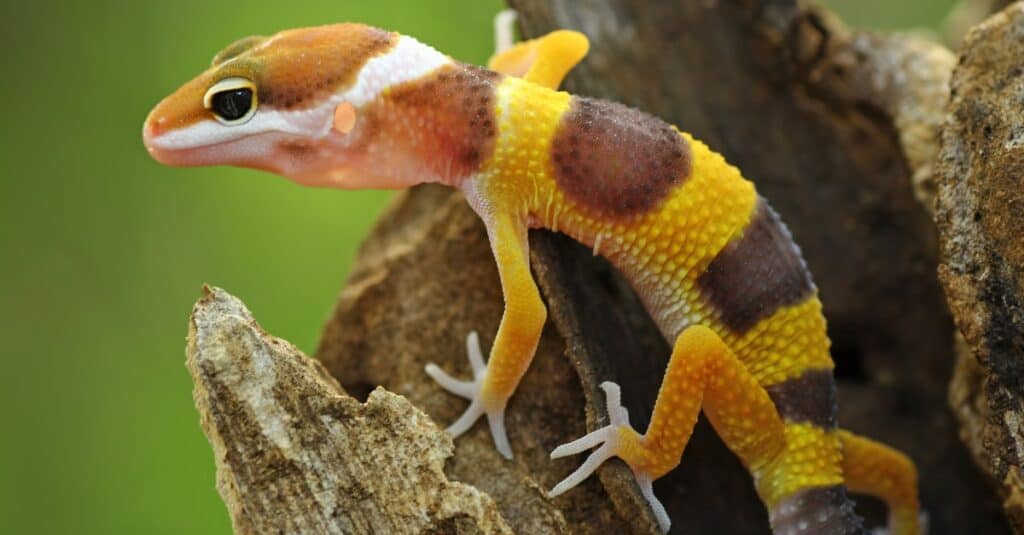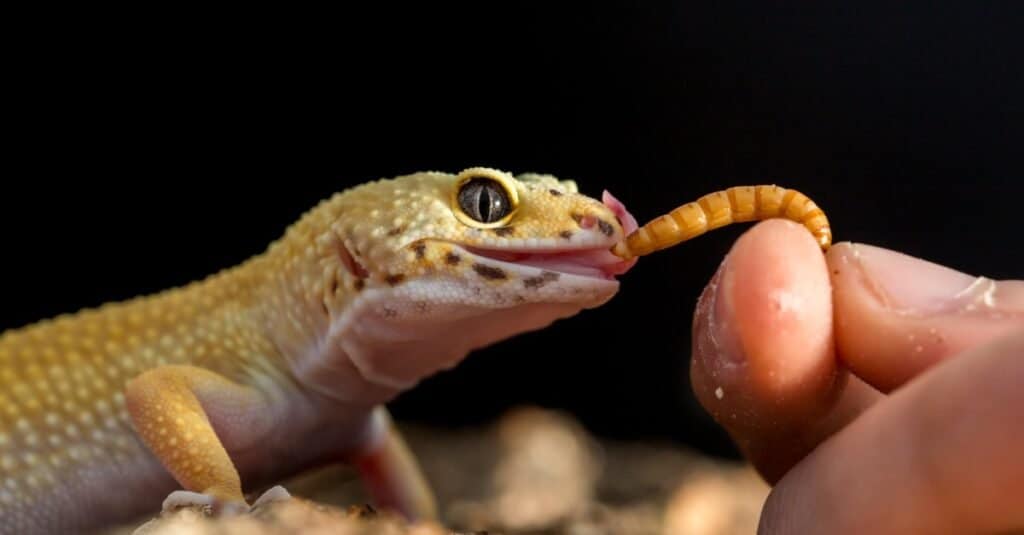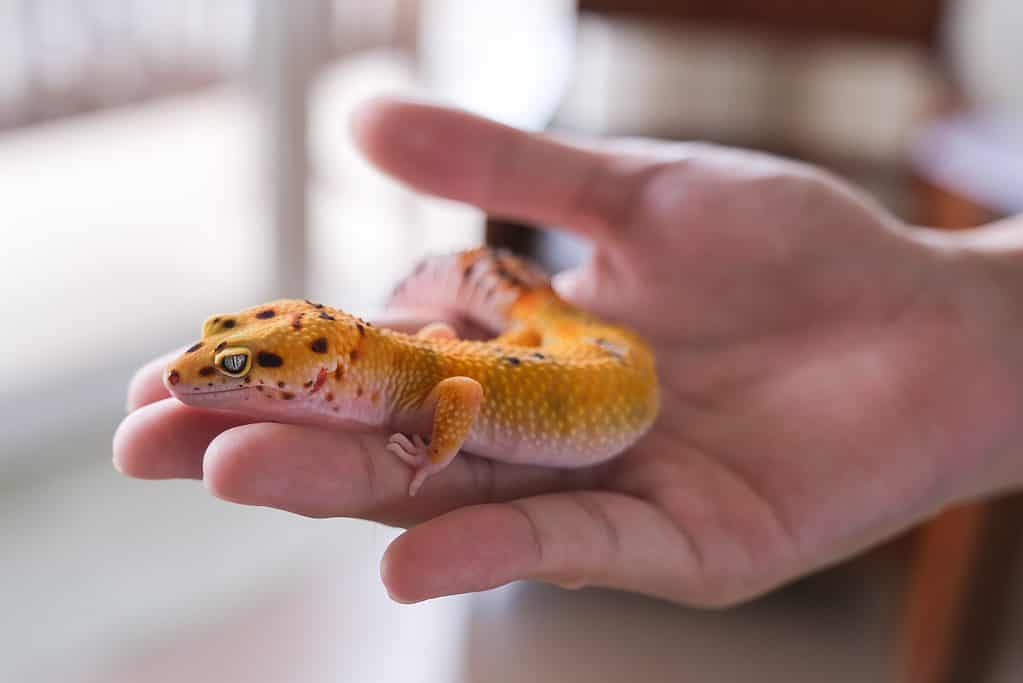When adopting any new pet, it helps to know how large they will eventually become. This is especially true with reptiles! Many species of lizards, including leopard geckos, start out as very tiny hatchlings yet eventually grow to more than triple their size within a few short months. To properly care for and accommodate your new scaly friend, you’ll need to understand healthy leopard gecko size ranges and how quickly these lizards grow during each stage of life.
After all, the size of any pet reptile will determine the size of their enclosure as well as the appropriate sizes for their food. Read on to learn more about the average leopard gecko’s growth rate and how big you can expect yours to become in terms of weight and length once they reach their full adult size.
How Big Are Baby Leopard Geckos?

Baby leopard geckos are only a few inches long and weigh less than 10 grams
©iStock.com/agus fitriyanto
Baby leopard geckos are known as hatchlings from roughly 0 to 2 months old. They hatch from small, fragile, soft-shelled eggs that are only around 1.5 to 2 inches long! Immediately after hatching, the average baby leopard gecko is usually approximately 3 to 4 inches long and around 2 to 5 grams in weight.
Fortunately, these adorable reptiles are only this small and fragile for a few months. They grow very rapidly during their first few months of life. After reaching two months old, they are officially considered juveniles. At this point, most juvenile geckos are around 5 inches long and 15 to 25 grams in weight. They will remain in the juvenile growth stage from 2 months to around 7 months of age.
Leopard geckos have four loosely defined growth stages: hatchling, juvenile, sub-adult, and adult. Now that we’ve covered how big you can expect your baby gecko to be within their first 6 months, let’s get into their sub-adult and eventual adult sizes!
How Big Are Adult Leopard Geckos?

Leopard geckos reach adulthood at around 12 months, but they don’t stop growing until around 18 months of age.
©iStock.com/erllre
After the juvenile stage of life ends, most leopard geckos’ growth rates begin to slow down drastically. However, your scaly friend isn’t done growing just yet!
The sub-adult stage starts when a gecko is roughly 7 to 8 months old. At this point, your gecko should be about 6 to 7 inches in length and anywhere from 30 to 40 grams in weight. This is also around when geckos start to outgrow their initial enclosures.
While a baby gecko can be safely housed in a 10-gallon enclosure, sub-adults and adults need a minimum of at least 20 gallons of space to feel comfortable. If you purchased a starter enclosure for your gecko, this is probably when you’ll need to buy them a larger, more permanent tank.
Your leopard gecko is finally considered an adult at around 12 months old for females, 6 months for males, 7+ inches long, and weighing roughly 50+ grams for males, and 45 grams for females. However, they won’t reach sexual maturity for several more months. This means you shouldn’t rush to breed your gecko until they’re at least 18 months old and weighs at least around 60 grams for their own safety.
When Do Leopard Geckos Stop Growing?

A healthy-looking, fully grown adult leopard gecko.
©iStock.com/Nynke van Holten
It is normal for leopard geckos to continue growing throughout their adult stage and well past their first year of life. Generally, they won’t stop growing completely until they are around a year and a half old. Depending on your gecko’s morph, sex, and genetics, they could reach well over 100 grams and over 10 inches long!
The bulk of a typical leopard gecko’s growth occurs during the first 6 months of life. This is when their growth rate is the most rapid. They will put on around 5 to 10 grams each month until they hit roughly 7 or 8 months old.
Most geckos’ growth rates begin to slow down considerably once they approach their sub-adult age and size. At this point, you can expect your gecko to only put on a few grams per month until they finally reach their ultimate adult size at around 18 months old.
Encouraging Healthy Leopard Gecko Growth

A nutritious diet is essential to facilitating healthy growth for leopard geckos of all ages and sizes.
©iStock.com/MattiaATH
Aside from a properly sized enclosure (10+ gallons for babies and 20+ gallons for juveniles and up), there are a few key tips to keep in mind as a reptile owner to ensure your gecko grows properly.
First, it is essential for a captive leopard gecko to have a varied, nutritious diet and a regular calcium supplement regardless of their growth stage. A diverse diet of insects is the best way to encourage your gecko to grow at a normal rate.
Don’t feed your leopard the same thing every single day! There are many great feeder insects to choose from, from crickets and mealworms to Dubia roaches and waxworms. All of these insects have their own specific protein, moisture, fat, and nutrient contents.
Be sure to coat feeder insects generously in calcium powder before each meal. Captive geckos require lots of additional calcium to prevent muscle and bone issues, especially at a young age.
In addition, carefully monitor the temperature and humidity within their enclosure and adjust them as needed. Improper temperature or humidity settings will stunt your pet’s growth in the long term and leave them prone to numerous health issues and illnesses, from respiratory infections and metabolic bone disease to simply being incapable of digesting their food properly.
Finally, weigh and measure your gecko weekly as they grow and compare their size alongside a growth chart to ensure everything is going smoothly. If they seem very small for their age, it’s probably time for a check-up with your reptile vet to make sure nothing is amiss health-wise.
Do Leopard Geckos Like to be Held?

There are at least four species of leopard geckos, including the tangerine leopard gecko which has a beautiful orange color.
©Nana Margono/Shutterstock.com
These adorable little geckos are particular about how they are handled. It is one of a handful of lizards that enjoy being touched, but if not done properly, they won’t be happy. While every gecko is different, they tend to like being petted on their heads and should you want to hold them, there are certain measures to follow to avoid an angry gecko.
You should start holding them at an early age to get them used to you. To get them accustomed to this, follow these steps:
- Slowly slide your hand toward them so they can see you, and then slide your hand under their bellies. Your hand should always be open and relaxed so your gecko doesn’t feel trapped.
- If caged, gently pick them up and place them on a flat surface, preferably close to, or on the floor to avoid injury should they fall. You should then let them simply relax in your hand, or on your arm, or just let them crawl around.
The photo featured at the top of this post is © iStock.com/erllre
Thank you for reading! Have some feedback for us? Contact the AZ Animals editorial team.






